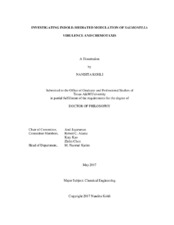| dc.description.abstract | The microbial community present in the gastrointestinal tract is an important component of the host defense against pathogen infections. Prior work from our lab demonstrated that indole, a microbial metabolite of tryptophan, reduces enterohemorrhagic Escherichia coli O157:H7 attachment to intestinal epithelial cells and biofilm formation, suggesting that indole may be an effector/attenuator of colonization for a number of enteric pathogens. Here, we show that indole attenuates Salmonella Typhimurium (Salmonella) virulence and invasion as well as increases resistance of host cells to Salmonella invasion. Indole-exposed Salmonella colonized mice less effectively compared to solvent-treated controls, as evident by competitive index values less than 1 in multiple organs. Indole-exposed Salmonella demonstrated 160-fold less invasion of HeLa epithelial cells and 2-fold less invasion of J774A.1 macrophages, compared to solvent-treated controls. However, indole did not affect Salmonella intracellular survival in J774A.1 macrophages, suggesting that indole primarily affects Salmonella invasion. The decrease in invasion was corroborated by a decrease in expression of multiple Salmonella Pathogenicity Island-1 (SPI-1) genes. Indole also reduced Salmonella motility and acts as a chemo-repellent through the Tsr chemoreceptor. We also identified that the effect of indole on Salmonella virulence was mediated by both PhoPQ-dependent and independent mechanisms. Further investigation of PhoPQ-dependent mechanism using Autodock Vina, Molecular Dynamic simulations and in vitro mutagenesis experiments revealed that indole does not bind to the periplasmic domain of PhoQ. Computational analysis predicted indole-binding to the cytoplasmic catalytic domain. Indole also synergistically enhanced the inhibitory effect of a short chain fatty acid cocktail on SPI-1 gene expression. Lastly, indole-treated HeLa cells were 70% more resistant to Salmonella invasion suggesting that indole also increases resistance of epithelial cells to colonization. Our results demonstrate that indole is an important microbiota metabolite that has direct anti-infective effects on Salmonella and host cells, revealing novel mechanisms of pathogen colonization resistance. | en |


